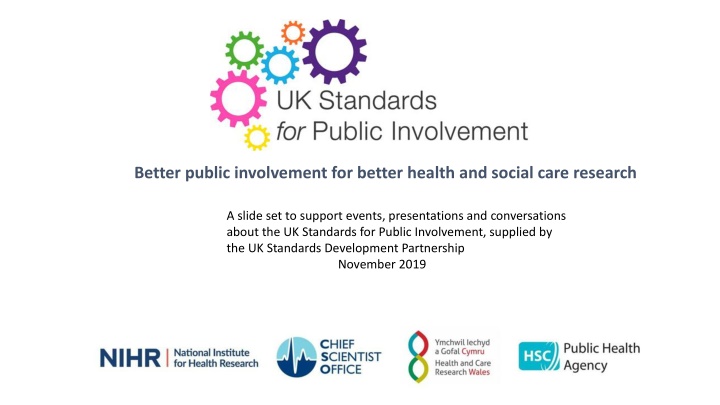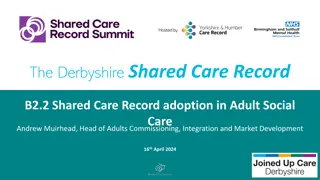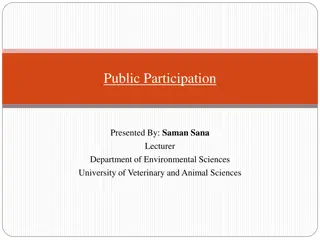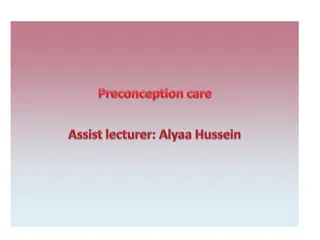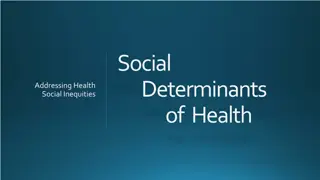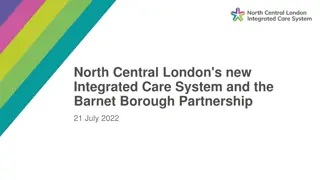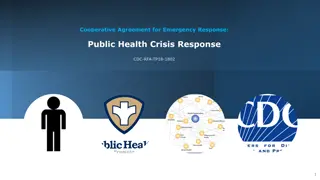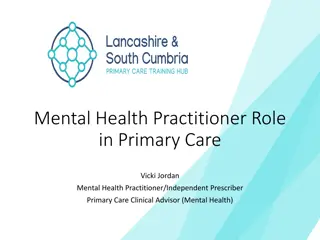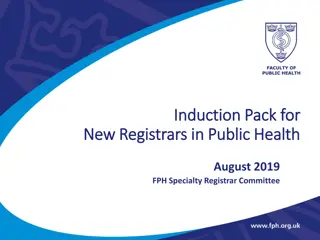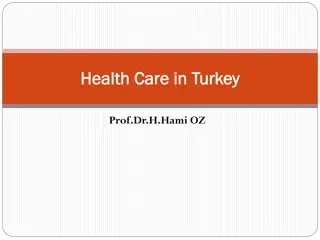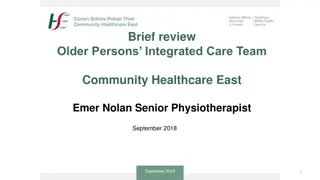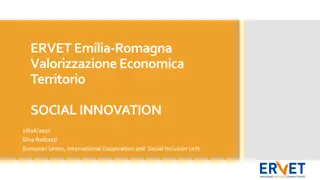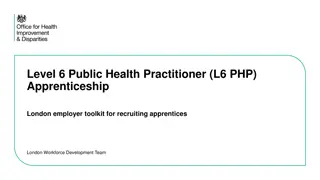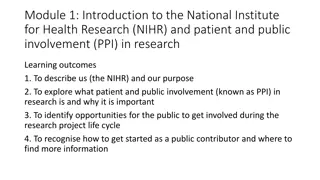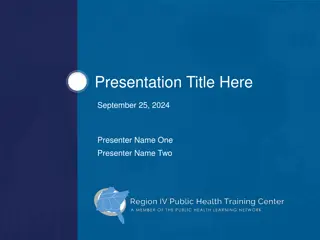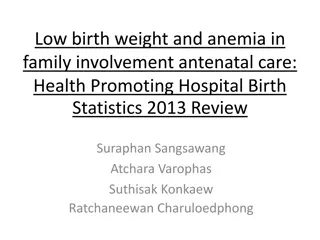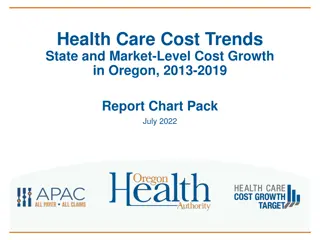Enhancing Public Involvement for Improved Health and Social Care Research
Explore the UK Standards for Public Involvement in Research, a comprehensive set of guidelines developed to enhance the quality and consistency of public engagement in health and social care research. These standards, encompassing areas like working together, support and learning, communications, governance, and impact, aim to promote inclusive opportunities and collaboration for a more impactful research environment. Foster reflective practices and encourage better engagement by integrating these standards into research activities.
Download Presentation

Please find below an Image/Link to download the presentation.
The content on the website is provided AS IS for your information and personal use only. It may not be sold, licensed, or shared on other websites without obtaining consent from the author.If you encounter any issues during the download, it is possible that the publisher has removed the file from their server.
You are allowed to download the files provided on this website for personal or commercial use, subject to the condition that they are used lawfully. All files are the property of their respective owners.
The content on the website is provided AS IS for your information and personal use only. It may not be sold, licensed, or shared on other websites without obtaining consent from the author.
E N D
Presentation Transcript
Better public involvement for better health and social care research A slide set to support events, presentations and conversations about the UK Standards for Public Involvement, supplied by the UK Standards Development Partnership November 2019
UK Standards for Public Involvement Better public involvement for better health and social care research A set of UK standards designed to improve the quality and consistency of public involvement in research Developed over 3 years by a 4-nation partnership and tested by 40+ individuals, groups and organisations during a year-long pilot programme. The standards are for everyone doing health or social care research. They can also be used in other contexts too. They are a description of what good public involvement looks like and are designed to support self-reflection and learning Reflective questions accompany each Standard to encourage users to think about their public involvement plans and actions They provide guidance and reassurance for users working towards achieving their own best practice.
Introducing the UK Standards for Public Involvement in Research
The Standards INCLUSIVE OPPORTUNITIES WORKING TOGETHER SUPPORT AND LEARNING COMMUNICATIONS IMPACT GOVERNANCE
The Standards more detail WORKING TOGETHER Work together in a way that values all contributions, and that builds and sustains mutually respectful and productive relationships INCLUSIVE OPPORTUNITIES Offer public involvement opportunities that are accessible and that reach people and groups according to research needs COMMUNICATIONS Use plain language for well timed and relevant communications, as part of involvement plans and activities GOVERNANCE Involve the public in research management, regulation, leadership and decision making SUPPORT AND LEARNING Offer and promote support and learning opportunities that build confidence and skills for public involvement in research IMPACT Seek improvement, by identifying and sharing the difference that public involvement makes to research
What the Standards represent Consensus on six important values-based areas to improve the quality of public involvement in research Reflective questions for each Standard to encourage users to think about their public involvement plans and actions Guidance and reassurance for users working towards achieving their own best practice The natural progression from previous work by National Institute for Health Research (NIHR) and Health Care Research Wales on values and principles in public involvement in research. Informed by Northern Ireland Public and Personal Involvement Standards and the Scottish Community Engagement Standards, amongst others.
Who the Standards are for The standards are for people and organisations that do research, support research and do public involvement to improve research. For example: Researchers and research organisations can use the standards to assess their plans and activities for public involvement and identify how to improve Public Involvement managers and facilitators can consider the standards a framework to reflect on and plan their activities Members of the public and community groups can use the standards to assess the strengths and weaknesses of their experience of involvement in research.
How the Standards can help Improving public involvement practice - providing examples of good practice Supporting leadership and accountability for involvement within research organisations Public involvement is everyone s job No single way of using the standards - how they are used will be influenced by many issues, such as the purpose of involvement and the amount of resources (money, people, skills) available.
Putting the standards into practice piloting phase 2018/19
Standards Pilots 2018/19 - Summary 40 organisations, groups and individuals (Pilots) across the UK a broad range of experience, funding for involvement and research focus. Mix of formal structured test beds (10) and informal freestyle projects (30) Applied the Standards for up to a year and shared progress with the Partnership Most popular Standards: Inclusive Opportunities, Working Together and Support and Learning less popular and more challenging were Impact and Governance Most of the pilots found the standards useful - they had improved or started to improve practice* Feedback and Improvements to the standards were suggested & implemented
Standards Pilots: How the Standards were used as a framework for public involvement supporting reflective practice and plans for future activities as a framework for public involvement supporting reflective practice and plans for future activities; as an audit /mapping tool identify gaps and areas for improvement; and for support and reassurance that they were working towards achieving best practice as a framework for public involvement supporting reflective practice and plans for future activities; as an audit /mapping tool identify gaps and areas for improvement; and for support and reassurance that they were working towards achieving best practice by applying a Standard such as Communication and reviewing all public involvement information used in the organisation as an audit /mapping tool identify gaps and areas for improvement as a way of prioritising involvement activity, e.g. identifying 3 areas of focus that are achievable in a timeframe to harmonise public involvement processes across different settings
What people said GOVERNANCE A skills audit of public contributors and other members of governance groups can be useful, both to play to people s strengths and assets and to make skills and value more transparent to the group It s important to have buy-in from senior management to ensure involvement is properly resourced and PPI Teams have the time to organise things. COMMUNICATIONS: We focused on making all our communications accessible. This one standard crossed over to other standards. It completely changed our thinking We took additional time to prepare resources appropriate to different groups to avoid tokenism
INCLUSIVE OPPORTUNITIES: This standard made us think more broadly. Previously we had variable involvement, no clear role descriptions or expenses policies. We began to make small changes accepting what was realistic given our limited resources. Diversity is a weakness in PPI. The standards help to highlight this along with other weaknesses. WORKING TOGETHER: Standards gave us a framework to stand back, think clearly and work with researchers, members of the public and others to develop an action plan to support joint working We worked together with our public contributors to create and develop new resources and activities to improve public involvement
SUPPORT AND LEARNING : What people said The standards have acted as a best practice guide, informing our public involvement activity. Referring to them has been reassuring. We feel better equipped to advise colleagues about involving the public in research now that they have a resource that they can refer to reflect on what they are doing and identify ways they can improve IMPACT:What people said We approached this by carrying out an assessment from the patients perspective of their experience of being involved in implementing the standards focusing on what was good/ not so good/ what should happen next. Putting the Standards into practice has resulted in some changes to our practice but more importantly, enabled reflection on our practice and our ambitions to improve
Standards Pilots: Challenges & learning Involvement is already squeezed so to then implement the standards was extra and required everyone to be generous with their time. We need to be careful that the standards are not seen as a stick to beat people with. Encourage people to believe in what they re doing not see PPI and the standards as a tick box exercise. We feel that it is not appropriate that all the Standards are applied to all research projects in the same way as they might be applied to a research organisation.
Standards Pilots: Overall experience & feedback How useful the pilot sites found each of the Standards Really Useful Somewhat Useful Neither Useful or not useful Not at all useful Not Applicable Improvement effect of the Standards during the piloting phase (2018-19) 25 22 Number of pilot sites 19 19 20 18 18 17 17 17 16 15 15 2% 15 13 They haven t improved practice Created ambition to improve Started to improve Improved everyday practice Don't know 2% 10 4 3 3 5 2 2 2 2 24% 1 1 1 1 0 0 0 0 0 0 0 0 39% INCLUSIVE OPPORTUNITIES WORKING TOGETHER SUPPORT & LEARNING COMMUNICATION IMPACT GOVERNANCE Bar Chart representing pilot responses to the question: Of the standards you used, please rate how useful you found each of them. (N=40) 33% Pie chart illustrating pilot responses to the survey question: In general, how have the standard(s) improved your/your organisation's practice? (N=40)
Key messages for users 1. Don t be afraid to use the standards experiment with how they can apply to your research/project/context. 2. Look for and use existing resources/materials there are many online public involvement resources already available. 3. Seek support and advice from your organisation s public involvement contact/team
The journey so far November 2019 2013-15 2016/17 2017/18 2018/19 2019/20 2015/16 2020/21 onwards: Supporting uptake and implementation Identified need why standards? Establish 4- nations partnership, draft standards Establish and maintain buy- in / stakeholder engagement Public Test & evaluate revised standards (pilot phase) Release final set of standards - and roll out consultation, revision of standards
Standards community Over 40 Pilots 2018 19 Standards Network Charities Involving People Network, Wales DEVELOPMENT PARTNERSHIP Industry Members of the public Universities INVOLVE members and associates Health & Social Care Administrations Original standards Pathfinders Public involvement practitioners .and many more
The full Standards and Reflective Questions
INCLUSIVE OPPORTUNITIES Offer public involvement opportunities that are accessible and that reach people and groups according to research needs Research to be informed by a diversity of public experience and insight, so that it leads to treatments and services which reflect these needs The questions below may help you reflect on and decide if you meet the standard: Are people affected by and interested in the research involved from the earliest stages? Have barriers to involvement, such as payment for time or accessible locations for meetings been identified and addressed? How is information about opportunities shared, and does it appeal to different communities? Are there fair and transparent processes for involving the public in research, and do they reflect equality and diversity duties? Is there choice and flexibility in opportunities offered to the public?
GOVERNANCE Involve the public in research management, regulation, leadership and decision making Public involvement in research governance can help research be more transparent and gain public trust The questions below may help you reflect on and decide if you meet the standard: Are public voices heard, valued and respected in decision making? Are public involvement plans in place that are regularly monitored, reviewed and reported on? Is there visible and accountable responsibility for public involvement throughout the organisation? Are realistic resources (including money, staff, time) allocated for public involvement? Is the privacy of personal information protected by collecting and using it in a suitable way?
WORKING TOGETHER Work together in a way that values all contributions, and that builds and sustains mutually respectful and productive relationships Public involvement in research is better when people work together towards a common purpose, and different perspectives are respected The questions below may help you reflect on and decide if you meet the standard: Has the purpose of public involvement been jointly defined and recorded? Have the practical requirements and arrangements for working together been addressed? Have all the potential different ways of working together been explored, and have these plans and activities been developed together? Is there is a shared understanding of roles, responsibilities and expectations of public involvement? Have individuals influence, ideas and contributions been recognised and addressed?
SUPPORT AND LEARNING Offer and promote support and learning opportunities that build confidence and skills for public involvement in research. Remove practical and social barriers that stop members of the public and research professionals from making the most of public involvement in research. The questions below may help you reflect on and decide if you meet the standard: Is there a range of support to address identified needs? Have specific resources been designated to support learning and development opportunities for both the public, researchers, and staff? Do the public know where to go for information and support about public involvement? Is there a culture of learning by doing, building on and sharing that learning for researchers, staff and the public?
IMPACT Seek improvement by identifying and sharing the difference that public involvement makes to research Understand the changes, benefits and learning gained from the insights and experiences of patients, carers and the public The questions below may help you reflect on and decide if you meet the standard: Are the public involved in deciding what the assessment of impact should focus on, and the approach to take? Is it clear what information to collect to help assess impact, including who has been involved and how? Are there processes in place to help reflect on public involvement? Are the changes, benefits and learning resulting from public involvement acted on?
COMMUNICATIONS Use plain language for well-timed and relevant communications, as part of involvement plans and activities Communicate with a wider audience about public involvement and research, using a broad range of approaches that are accessible and appealing The questions below may help you reflect on and decide if you meet the standard: Has a communications plan been developed for involvement activities? Are the needs of different people being met through inclusive and flexible communication methods? Are processes in place to offer, gather, act on and share feedback with the public? Are you sharing your public involvement learning and achievements, good and bad?
The Standards INCLUSIVE OPPORTUNITIES: Offer public involvement opportunities that are accessible and that reach people and groups according to research needs. WORKING TOGETHER: Working together in a way that values all contributions, and that builds and sustains mutually respectful and productive relationships. SUPPORT AND LEARNING: Offer and promote support and learning opportunities that build confidence and skills for public involvement in research. COMMUNICATIONS: Use plain language for well-timed and relevant communications as part of involvement plans and activities. IMPACT: Seek improvement by identifying and sharing the difference that public involvement makes to research. GOVERNANCE: Involve the public in research management, regulation, leadership and decision making.
Resources and support where to go UK Standards for Public Involvement website: https://sites.google.com/nihr.ac.uk/pi-standards/home INVOLVE website: https://www.invo.org.uk/ Learning for Involvement website: http://learningforinvolvement.org.uk/ Health Research Authority Public Involvement: https://www.hra.nhs.uk/planning-and-improving-research/best- practice/public-involvement/
Acknowledgements The UK Public Involvement Standards Development Partnership group would like to thank everyone who gave their time and input to the development of the standards. A special thank you to the pilot implementation teams across the UK, who used the standards for a year and shared their experiences. Thanks to everyone that took part in the initial workshop, the consultation, and shared their views via Social Media. We also thank; Maryrose Tarpey for the analysis and reporting of pilot data (2019); The North East Research Design Service and their Public Group for supporting analysis and reporting of public consultation (2017) and members of the Standards Network 2017 2019.
Thank you & join the conversation! #UKPIStandards @NIHRINVOLVE, @publichealthni, @CSO_Scotland, @ResearchWales https://sites.google.com/nihr.ac.uk/pi-standards/home
